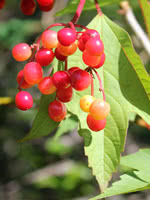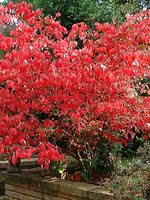Mon-Fri 9am - 5pm Mountain time
Highbush Cranberry vs Burning Bush
Viburnum opulus var. americanum (trilobum)
Euonymus alatus
Highbush Cranberry produces attractive white flowers in late June and bears edible fruit that matures to a bright red colour in the late summer.
This shrub, native to much of Canada, is fast growing, and its fruit can be eaten raw or cooked into a sauce.
Burning Bush is a unique shrub whose leaves turn firey red in the fall. You can plant it in rows to make a hedge or on its own. Burning Bush requires little maintenance and thrives in just about any kind of soil, which makes it a good choice for inexperienced growers. Plant it in full sun to get its best fall color.
Select Cultivar: Dwarf Burning Bush is a smaller variety of Burning Bush. This shrub has a compact form and only reaches 4-5ft tall and 4-5ft wide.
Note: Burning Bush is considered an invasive species in eastern North America. Please plant the right tree in the right place.
Highbush Cranberry Quick Facts
Burning Bush Quick Facts
In row spacing: 0.6 m (2.0 ft)

